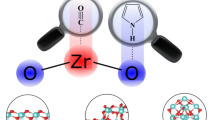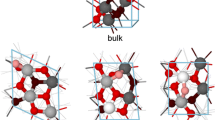Abstract
The adsorption of six amino acids onto (111) surface of cubic ZrO2 was theoretically investigated using density functional theory (DFT). DFT calculations with D3 dispersion correction were carried out with the PBE exchange–correlation functional. Mechanism, molecular adsorption structures, and energies were calculated. The (111) surface of cubic ZrO2 was modeled using a slab with 9 atomic layers (81 atoms). The slab thickness was 7.3 Å, and a vacuum separation of 12 Å was used with periodic boundary conditions. The results showed that the order of the molecular adsorption energies is ASP > HYP > GLY > ALA > LYS > PRO. Furthermore, adsorption of amino acids on the zirconia surface showed complete hydrogen transfer from GLY, ALA, HYP, and ASP to the surface. For LYS and PRO, hydrogen transfer does not occur. Topological analysis of the electron localization function (ELF) was applied to study the nature of the molecule-surface interactions. It was found that the dissociation of molecules and strong chemical bonds of adsorbed atoms to surface oxygen atoms play an important role in the adsorption mechanism.




Similar content being viewed by others
References
H. Shahzad, R. Ahmadi, F. Adhami, J. Najafpour, Eurasian Chem. Commun. 2, 162 (2020). https://doi.org/10.33945/SAMI/ECC.2020.2.1
R. Faramarzi, M. Falahati, M. Mirzaei, Adv. J. Sci. Eng. 1, 62 (2020). https://doi.org/10.22034/AJSE.2012062
M. Afshar, R.R. Khojasteh, R. Ahmadi, Eurasian Chem. Commun. 2, 595 (2020). https://doi.org/10.33945/SAMI/ECC.2020.5.5
M. Mirzaei, M. Yousefi, Superlattices Microstruct. 52, 612 (2012). https://doi.org/10.1016/j.spmi.2012.06.027
H. Behzadi, N.L. Hadipour, M. Mirzaei, Biophys. Chem. 125, 179 (2007). https://doi.org/10.1016/j.bpc.2006.07.010
J. Pryjmaková, M. Kaimlová, T. Hubáček, V. Švorčík, J. Siegel, Int. J. Mol. Sci. 21(7), 2521 (2020). https://doi.org/10.3390/ijms21072521
K. Parratt, N. Yao, Nanomaterials (Basel) 3(2), 242 (2013). https://doi.org/10.3390/nano3020242
M. Vert, Y. Doi, K. Hellwich, M. Hess, P. Hodge, P. Kubisa, M. Rinaudo, F. Schué, Pure Appl. Chem. 84, 377 (2012). https://doi.org/10.1351/PAC-REC-10-12-04
C.J. Wilson, R.E. Clegg, D.I. Leavesley, M.J. Pearcy, Tissue Eng. 11, 1 (2005). https://doi.org/10.1089/ten.2005.11.1
F. Rupp, R.A. Gittens, L. Scheideler, A. Marmur, B.D. Boyan, Z. Schwartz, J. Geis-Gerstorfer, Acta Biomater. 10, 2894 (2014). https://doi.org/10.1016/j.actbio.2014.02.040
T. Inoue, K. Matsuzaka, Interface Oral Health Science, (Springer, Tokyo, 2014), p. 33. https://doi.org/10.1007/978-4-431-55192-8_3
L. Vroman, A.L. Adams, G.C. Fischer, P.C. Munoz, Blood 55, 156 (1980). https://doi.org/10.1182/blood.V55.1.156.156
R.F. Sabirianov, A. Rubinstein, F. Namavar, Phys. Chem. Chem. Phys. 13, 6597 (2011). https://doi.org/10.1039/C0CP02389B
S. Gupta, J. Dent. Implants Denture. 1, 113 (2015). https://doi.org/10.4172/2572-4835.1000113
S.H. An, T. Matsumoto, H. Miyajima, A. Nakahira, K.H. Kim, S. Imazato, Dent. Mater. 28, 1221 (2012). https://doi.org/10.1016/j.dental.2012.09.001
W. Guocheng, L. Xuanyong, D. Chuanxian, in 3rd International Nanoelectronics Conference (INEC), (IEEE, Hong Kong, 2010), p. 844. https://doi.org/10.1109/INEC.2010.5425174
W. Guocheng, M. Fanhao, D. Chuanxian, P.K. Chu, L. Xuanyong, Acta Biomater. 6, 990 (2010). https://doi.org/10.1016/j.actbio.2009.09.021
S. Jalili, M. Keshavarz, Comp. Theo. Chem. 1173, 112702 (2020). https://doi.org/10.1016/j.comptc.2020.112702
D.G. Arquès, J.P. Fallot, C.J. Michel, Int. J. Biol. Macromol. 19(2), 131 (1996). https://doi.org/10.1016/0141-8130(96)01115-4
H. DLodish, A. Berk, S. L. Zipursky, et al., Molecular Cell Biology. 5th edn. (W. H. Freeman: New York, 2003)
J.P. Perdew, K. Burke, M. Ernzerhof, Phys. Rev. Lett. 77, 3865 (1996). https://doi.org/10.1103/PhysRevLett.77.3865
J.P. Perdew, K. Burke, M. Ernzerhof, Phys. Rev. Lett. 78, 1396 (1997). https://doi.org/10.1103/PhysRevLett.78.1396
P. Giannozzi et al., J. Phys.: Condens. Matter. 21, 395502 (2009). https://doi.org/10.1088/0953-8984/21/39/395502
K. Momma, F. Izumi, J. Appl. Crystallogr. 44, 1272 (2011). https://doi.org/10.1107/S0021889811038970
S.L. Dudarev, G.A. Botton, S.Y. Savrasov, C.J. Humphreys, A.P. Sutton, Phys. Rev. B 57, 1505 (1998). https://doi.org/10.1103/PhysRevB.57.1505
S. A. Tolba, K. M. Gameel, B. A. Ali, H. A. Almossalami, N. K. Allam, The DFT+U: Approaches, Accuracy and Applications (InTech Open, Rijeka, 2018). https://doi.org/10.5772/intechopen.72020
S. Grimme, J. Antony, S. Ehrlich, S. Krieg, J. Chem. Phys. 132, 154104 (2010). https://doi.org/10.1063/1.3382344
J. Moellmann, S. Grimme, J. Phys. Chem. C 118, 7615 (2014). https://doi.org/10.1021/jp501237c
T. Risthaus, S. Grimme, J. Chem. Theory Comput. 9, 1580 (2013). https://doi.org/10.1021/ct301081n
A.D. Becke, K.E. Edgecombe, J. Chem. Phys. 92, 5397 (1990). https://doi.org/10.1063/1.458517
X. Xia, Computational modelling study of yttria-stabilized zirconia, Phd Thesis (UCL, London, 2010). https://discovery.ucl.ac.uk/id/eprint/20483
A. Cadi-Essadek, A. Roldan, N.H. de Leeuw, J. Phys. Chem. C 119, 6581 (2015). https://doi.org/10.1021/jp512594j
A. Savin, A.D. Becke, J. Flad, R. Nesper, H. Preuss, H.G. von Schnering, Angew. Chem. Int. Ed. Engl. 30, 409 (1991). https://doi.org/10.1002/anie.199104091
A. Savin, R. Nesper, S. Wengert, T.F. Fassler, Angew. Chem. Int. Ed. Engl. 36(1809), 1809 (1997). https://doi.org/10.1002/anie.199718081
B. Silvi, in The Relevance of the ELF Topological Approach to the Lewis, Kossel, and Langmuir Bond Model, ed by D. Mingos. The Chemical Bond II. Structure and Bonding (Springer, Cham, 2015), p. 213–247. https://doi.org/10.1007/430_2015_185
P. Fuentealba, E. Chamorro, J.C. Santosb, in Chapter 5 Understanding and using the electron localization function. Theoretical Aspects of Chemical Reactivity (Elsevier B.V., 2007), p. 57–85. https://doi.org/10.1016/S1380-7323(07)80006-9
B. Silvi, J. Mol. Struc. 614, 3 (2002). https://doi.org/10.1016/S0022-2860(02)00231-4
R.J. Gillespie, E.A. Robinson, J. Comput. Chem. 28, 87 (2007). https://doi.org/10.1002/jcc.20545
G.N. Lewis, W.L. Jolly, Valence and the Structure of Atoms and Molecules (The Chemical Catalog Company, New York, 1923), p. 142
Author information
Authors and Affiliations
Corresponding author
Supplementary Information
Below is the link to the electronic supplementary material.
Rights and permissions
About this article
Cite this article
Jalili, S., Keshavarz, M. Amino acids adsorption onto the (111) surface of cubic zirconia: a density functional theory study. J IRAN CHEM SOC 18, 2801–2806 (2021). https://doi.org/10.1007/s13738-021-02234-8
Received:
Accepted:
Published:
Issue Date:
DOI: https://doi.org/10.1007/s13738-021-02234-8




